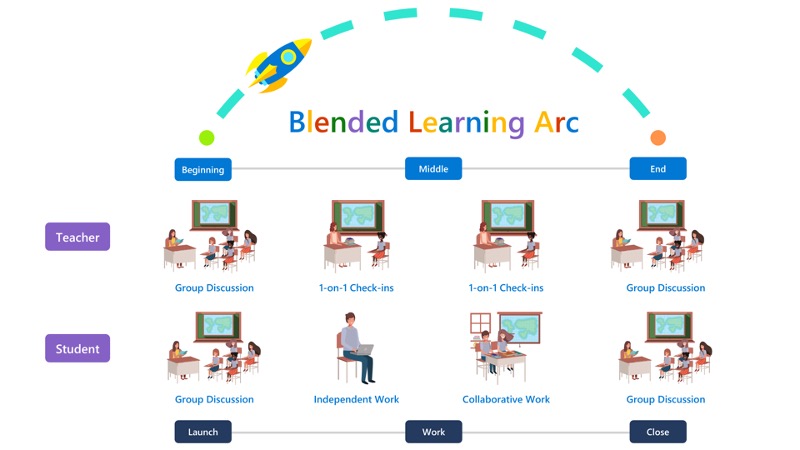Modalities of blended learning and the learning arc
The blended learning arc is a process teachers use in any blended learning model to engage students and facilitate instructional learning experiences, whether it's an instructional block, week, or semester.

There are four core modalities that frame the teaching and learning within the blended learning arc.
LAUNCH: Group discussion
Creating a blended learning environment in classrooms starts with identifying a desired outcome. With this in mind, blended learning is launched through group discussion (in person or using Microsoft Teams meetings) that begins the learning and assists in planning the work students will be doing in person or online.
WORK: Independent work
Providing opportunities for students to work and learn independently in order to practice and demonstrate their understandings promotes student agency and ownership of the learning process. Teachers scaffold work in order to empower students to work independently to help them develop the skills they need to grow as learners.
WORK: Small group collaboration
Learning is social and working in collaboration fosters student communication, inclusion, problem-solving, and community. (Collaboration here means to communicate ideas and resources in pairs or groups where all students have shared responsibility to own their contribution, collectively make decisions, and be mutually responsible for the shared group product or response.) Teachers in blended learning classrooms design ways for all students to work in small groups.
WORK: 1:1 check-ins
Monitoring students‘ independent and collaborative work during the learning process is vital for both students and teachers progress and growth. Collecting and analyzing the data from the work students demonstrate shapes future support for the student and teaching opportunities for the teacher.
CLOSE: Group discussion
Teachers and students return to a group discussion to close the blended learning arc by sharing knowledge gained, new understandings, praise, and reflection on the outcomes, learning processes, pace, and student agency during the learning. Group discussion is also a time for questions, ideas, and ways to demonstrate learning that can support launching a new (or the next) learning arc.
Graphic from: https://www.readytoblend.com/post/hacks-for-helping-students-achieve-in-class-or-from-home

Blended learning models
There are various blended learning models that teachers (and schools) can implement. Each model has specific ways to target teaching and learning. Each also incorporates the blended learning arc and allows for students to have some agency over time (when), space (where they learn), pace (speed and rate of learning), and path (way in which they learn).
Rotation model
Students rotate on a fixed or teacher-led schedule to encounter learning experiences with at least one being online.
There are four different ways to implement rotations:
- Station rotation – All students cycle through each rotation.
- Lab rotation – Students rotate to a computer lab for online learning.
- Flipped classroom – Primary content delivery is online followed by teacher-guided work and practice in-person.
- Individual rotation – Students have an individualized playlist they rotate or work through with at least one component online.
Flex model
Primary instruction is online delivery with in-person enrichment through small group instruction, group projects, and individual tutoring as needed.
A la carte model
Courses and instruction entirely online (completed on-campus or off-site) that also accompany other experiences offered within a learning center or school.
Enriched virtual model
Students are required to have in-person learning sessions with their teacher and then complete their remaining coursework remotely with the same teacher assessing work.
Source: Michael B. Horn and Heather Staker, Blended: Using Disruptive Innovation to Improve Schools (San Francisco: Jossey-Bass, 2014).